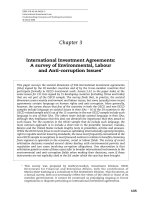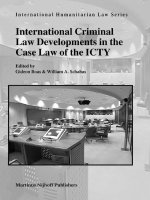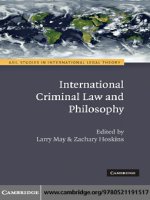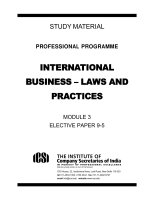International investment law CLC 2TC
Bạn đang xem bản rút gọn của tài liệu. Xem và tải ngay bản đầy đủ của tài liệu tại đây (253.16 KB, 23 trang )
HANOI LAW UNIVERSITY
FACULTY OF INTERNATIONAL TRADE AND BUSINESS LAW
APPROVAL OF PRINCIPAL
DETAILED OUTLINE
INTERNATIONAL INVESTMENT LAW
(FOR HLU INTERNAL USE ONLY)
HÀ NỘI - 2022
FACULTY OF INTERNATIONAL TRADE AND BUSINESS LAW
1
Program:
Bachelor of Law (High Quality Training
Program)
Course title:
International Investment Law
Credit points:
02
Type of the course:
Optional
1. INFORMATION OF LECTURERS
1.1 Lecturers
N
Name
Title
o
1. Ngo Trong LL.M
Quan
.
2. Nguyen Ba Assoc
Binh
. Prof.
3. Nguyen Thi LL.M
Anh Tho
.
m
4. Nguyen
LL.M
Mai Linh
.
5. Doan Thanh LL.M
Huyen
.
6. Trinh Hai Ph.D
Yen
7. Lai Thi Van LL.M
Anh
.
8. Nguyen Thi LL.M
Nhung
.
9. Dinh Anh LL.M
Tuyet
.
10. Nguyen
LL.M
Huu Phu
.
11. Vo Le Nam LL.M
Tel
04.37731787
04.37731787
04.37731787
04.37731787
04.37731787
04.37731787
04.37731787
04.37731787
04.37731787
04.37731787
04.37731787
2
.
1.2 Assistants
N
Name
o
1. Le Dinh Quyet
2.
Do Thu Huong
Title
LL.M.
LL.M.
m
m
Tel
04.3773178
7
04.3773178
7
Office of Department of Multilateral Trade and International
Investment Law
Room A1401, Building A, Hanoi Law University
No. 87, Nguyen Chi Thanh Street, Dong Da, Ha Noi
Working hours: 8h00 – 17h00 everyday (except for Saturday, Sunday, and
holidays)
2. PREREQUISITE COURSES
- Basic Legal English (CLC.ĐB09)
- Public International Law (CLC.CB20)
- International Trade and Business Law (CLC.CB23)
3. SUMMARY OF THE COURSE
International investment law has been emerging as a distinct and dynamic
field of international law. The course on International Investment Law
provides the basic knowledge of the legal system governing investment
liberalization, investment protection, the institutional, economic and
political influence on international investment. This course aims to
introduce students to the standards of treatment of foreign investments and
resolution of foreign investment disputes. The main topics in the course
include:
1) Overview of International Investment and International Investment Law
2) Fundamental Principles of International Investment Law
3) Viet Nam and International Investment Law
4. CONTENTS OF THE COURSE
3
Issue 1. Overview of International Investment and International
Investment Law
1.1. Globalization and International Investment
1.2. Historical Development of International Investment Law
1.3. Defining the Scope of Investment Treaties
1.4. Sources of International Investment Law
Issue 2. Fundamental Principles of International Investment Law
2.1. Most Favoured Nation (MFN)
2.2. National Treatment (NT)
2.3. Fair and Equitable Treatment (FET)
2.4. Full Protection and Security (FPS)
2.5. Protection against Unlawful Expropriation (Takings)
2.6. Investor-State Dispute Settlement (ISDS)
2.7. Umbrella Clause and Other Principles of Investment Protection
2.8. Exceptions to the Principles of International Investment Law
Issue 3. Viet Nam and International Investment Law
3.1. International Commitments of Vietnam Regarding Investment
3.2. Vietnamese Law Regulating International Investment Relations
3.3. Vietnam’s Investor-State Dispute Settlement (ISDS)
5. OUTPUT STANDARDS OF THE COURSE AND MAPPING WITH
THE OUTPUT STANDARDS OF THE TRAINING PROGRAM
5.1. The Course Learning Outcomes (CLOs)
This course aims at introducing students to the core principles of
international investment law and investment dispute settlement mechanism.
Students are encouraged to reflect on the economic activity of foreign
direct investment in its political and social context. Upon completion of the
course, students will be able to:
Knowledge
K1. Understand the historical context, sources and fundamental principles
of international investment law;
K2. Understand and interpret the international investment law texts,
4
especially investment treaties and investment disputes;
K3. Understand the investor-state dispute settlement mechanism (ISDS)
and international investment arbitration in particular;
K4. Understand the policies and legal framework in Vietnam regulating
international investment relations;
K5. Apply the substantive and procedural principles of international
investment law to explain the specific situations in relationships between
foreign investors and host states;
K6. Apply legal English in the field of international investment law.
Skills
S7. Search for and update international investment agreements and case
law;
S8. Conduct research on international investment law and arbitration;
S9. Design and deliver a presentation on international investment law;
S10. Work independently and collaboratively with other students to prepare
a research paper;
S11. Develop arguments and critical thinking to solve practical situations in
international investment law.
Self-control ability and self-responsibility
T12. Be confident, willing to acquire new knowledge and open to different
viewpoints in the field;
T13. Develop a sense of honesty, striving for progress and protection of
justice;
T14. Develop a sense of respect and compliance with the law;
T15. Develop professional working ethics.
5.2. The matrix demonstrating the compatibility of the CLOs with the
TPLOs
Course
Learning
Outcome
s
K1
The
Knowledge
LOs of the
training
program
K8
K13
The Skill LOs of the training
program
The ability
LOs of the
training
program
K16 S17 S18 S25 S26 S27 S28 S30 S31 T32 T33 T34
5
K2
K3
K4
K5
K6
S7
S8
S9
S10
S11
T12
T13
T14
T15
6. LEARNING OBJECTIVES
6.1. Detailed learning objectives
Objective
Issue
1.
Overview of
Internationa
l Investment
and
Internationa
l Investment
Law
Level 1
Level 2
Level 3
1A1.
Introducing the
history
of
economic
globalization
and international
investment.
1A2. Presenting
the
historical
development of
international
investment law.
1A3.
Listing
sources
of
international
1B1. Analysing the
reasons
that
investment treaties
have come to play
a dominant role in
investment
protection.
1B2. Analysing the
pros and cons of a
multilateral
investment
agreement.
1B3. Analysing the
concept of political
risk insurance as
1C1.
Giving
comments on
the the ways
investors
can
protect
their
rights in the
host countries.
1C2.
Giving
comments on
the sources of
international
investment law
in
dispute
settlement.
1C3.
Giving
6
investment law.
1A4.
Listing
different aspects
in the scope of
investment
treaties.
1A5.
Listing
customary
international law
governing
foreign
investment
relationships.
2.
2A1. Identifying
Fundamenta the components
l Principles of the most
of
favoured nation
Internationa (MFN)
l Investment principle.
Law
2A2. Identifying
the components
of the national
treatment (NT)
principle.
2A3. Identifying
the elements of
fair
and
equitable
treatment (FET)
principle.
2A4. Presenting
the scope of full
protection and
security (FPS)
an alternative or a
supplement
to
treaty
protection
and
dispute
settlement.
1B4. Analysing the
scope
of
a
particular
investment treaty
in terms of covered
investor
and
covered
investment.
2B1. Analysing the
interpretations of
MFN
by
investment
tribunals.
2B2. Analysing the
interpretations of
NT by investment
tribunals.
2B3. Analysing the
relationship
between
the
international
minimum standard
of treatment and
FET.
2B4. Analysing the
interpretation
of
FET in investment
disputes
2B5. Analysing the
comments on
the
current
features
of
treaty practice
and
arbitral
practice
in
international
investment law.
2C1. Assessing
the importance
of the like
circumstance
requirement and
relevance
of
WTO
jurisprudence.
2C2.
Giving
comments on
the impact of
fair
and
equitable
treatment
principle
on
investment
liberalization.
2C3.
Comparing the
fair
and
equitable
7
standard.
2A5. Presenting
the content of
protection
of
foreign investors
against unlawful
expropriation.
2A6. Presenting
the methods of
resolving
investor-state
disputes.
2A7. Presenting
the content of
other principles
of
investment
protection
(umbrella
clause, transfer
of
funds,
movement
of
natural persons,
performance
requirements).
2A8. Presenting
exceptions
of
the
basic
principles
of
international
investment law.
application of FPS
in
investment
disputes.
2B6.
Distinguishing
lawful
and
unlawful,
direct
and
indirect
expropriation.
2B7.
Distinguishing the
sole-effect doctrine
and police power
doctrine
in
determination of
indirect
expropriation
2B8. Analysing the
advantages
and
disadvantages of
investor-state
arbitration.
2B9. Analysing the
advantages
and
disadvantages of
diplomatic
protection.
2B10. Analysing
criticisms against
ISDS.
treatment
standard with
the
full
protection and
security
standard.
2C4.
Giving
comments on
recent
developments
and limitations
of investment
arbitration.
2C5. Assessing
the
jurisprudence
approaches to
interpretation of
umbrella
clauses.
2C6. Assessing
the role of
exceptions in
protecting
regulatory
space of host
states.
2C7.
Evaluating the
pros and cons
of an appellate
review
mechanism in
investment
arbitration
8
3A1. Presenting
the WTO, FTA
and
BIT
commitments of
Vietnam
regarding
international
investment
3A2. Presenting
the Vietnamese
3.
legal
system
Viet Nam
regulating
and
international
Internationa investment
l Investment relations
Law
3A3. Presenting
the coordination
process of ISDS
in Vietnam
3B1. Analysing the
content
of
investment treaties
of Vietnam
3B2.
Analysing
Vietnamese
law
regulating
international
investment
relations.
3B3. Analysing the
major differences
between traditional
and new generation
investment treaties
of Vietnam
3C1.
Giving
comments on
the Vietnam’s
commitments in
recent
investment
treaties
or
investment
chapters of free
trade
agreements
(CPTPP
and
EVIPA).
3C2.
Giving
comments on
the practice of
Vietnam’s
ISDS.
3C3.
Giving
comments on
the
new
investor-state
dispute
settlement
mechanism in
EVIPA.
6.2. Total learning objectives
Objectives
Issue
Issue 1
Issue 2
Issue 3
Total
Level 1
Level 2
Level 3
Total
5
8
3
16
4
10
3
17
3
7
3
13
12
25
9
46
9
7. THE MATRIX DEMONSTRATING THE COMPATIBILITY OF
THE DETAILED LEARNING OBJECTIVES WITH CLOs
Knowledge
Skills
Ability
Objectives
K1 K2 K3 K4 K5 K6 S7 S8 S9 S10 S11 T12 T13 T14 T15
1A1
1A2
1A3
1A4
1A5
1B1
1B2
1B3
1B4
1C1
1C2
1C3
2A1
2A2
2A3
2A4
2A5
2A6
2A7
2A8
2B1
2B2
10
2B3
2B4
2B5
2B6
2B7
2B8
2B9
2B10
2C1
2C2
2C3
2C4
2C5
2C6
2C7
3A1
3A2
3A3
3B1
3B2
3B3
3C1
3C2
3C3
8. MATERIALS
8.1. Compulsory materials
11
Hanoi Law University, Textbook on International Investment Law, Youth
Publishing House, Hanoi, 2017 (This Bilingual Textbook was published
within the framework of the EU-MUTRAP Project and can be downloaded
at />8.2. Recommended Materials
* Books
1. Andrew Newcombe, LLuis Paradell, Law and Practice of Investment
Treaties: Standards of Treatment, Kluwer Law International, 2009.
2. August Reinisch, Advanced Introduction to International Investment
Law, Edward Elgar Publishing, 2020.
3. C. L. Lim, Jean Ho, Martins Paparinskis, International Investment Law
and Arbitration: Commentary, Awards and other Materials (2nd edition),
Cambridge University Press, 2021.
4. Jean Ho, State Responsibility for Breaches of Investment Contracts,
Cambridge University Press, 2018.
5.
Jeffery Commission and Rahim Moloo, Procedural Issues in
International Investment Arbitration, Oxford University Press, 2018.
6. Johanne M. Cox, Expropriation in Investment Treaty Arbitration,
Oxford University Press, 2019.
7. Jurgen Kurtz, The WTO and International Investment Law: Converging
Systems, Cambridge University Press, 2016.
8. M. Sornarajah, The International Law on Foreign Investment,
Cambridge University Press, Third Edition, 2010.
9. Marie-Claire Cordonier Segger, Markus W. Gehring, Andrew
Newcombe, Sustainable Development in World Investment Law, Kluwer
Law International, 2011.
10. Mavluda Sattorova, The Impact of Investment Treaty Law on Host
States: Enabling Good Governance, Hart Publishing, 2018.
11. Peter Muchlinski, Federico Ortino, and Christoph Schreuer, The Oxford
Handbook of International Investment Law, Oxford University Press, 2008.
12. Peter Muchlinski, Multinational Enterprises and the Law (Third
Edition), Oxford University Press, 2019.
13. Surya P. Subedi, International Investment Law - Reconciling Policy
and Principle, Hart Publishing, Third Edition, 2020.
12
14. Thomas Cottier and Krista Nadakavukaren Schefer, Elgar Encyclopedia
of International Economic Law, Edward Elgar Publishing, 2017.
15. Wongkaew Teerawat, Protection of Legitimate Expectations in
Investment Treaty Arbitration, Cambridge University Press, 2019.
16. Yannick Radi, Rules and Practices of International Investment Law and
Arbitration, Cambridge University Press, 2020.
* Legal texts and reports
1. The ICSID Convention 1965.
2. The New York Convention 1958.
3. The ASEAN Comprehensive Investment Agreement (ACIA) 2009.
13
4. The North American Free Trade Agreement (NAFTA) 1994.
5. The European Union – Vietnam Investment Protection Agreement
(EVIPA) 2019.
6. The Comprehensive and Progressive Agreement for Trans-Pacific
Partnership (CPTPP) 2018.
7. The Vienna Convention on the Law of Treaties (VCLT) 1969.
8. International Law Commission Draft Articles on Responsibility of States
for Internationally Wrongful Acts 2001.
9. 2012 US Model Bilateral Investment Treaty,
/>10. Decision No. 14/2020/QD-TTg dated 08 April 2020 on Promulgation of
Regulation on Coordination in Resolution of International Investment
Disputes.
11. WTO, Report of the Working Party on the Accession of Viet Nam and
Viet
Nam’s
WTO
Commitments,
/>12.
WTO,
Trade
Policy
Review:
Viet
Nam,
/>13. UNCTAD, UNCTAD Series on Issues in International Investment
Agreements I/II
/> />14. UNCTAD,
Investment Policy Review: Vietnam, 2008,
/>15. OECD, OECD Investment Policy Reviews: Vietnam 2018,
/>16. OECD, OECD Investment Policy Reviews: Southeast Asia, 2018,
/>
14
17. World Bank, 2019 Investment Policy and Regulatory Review – Vietnam,
/>am-2019-Investment-Policy-and-Regulatory-Review.pdf?
sequence=1&isAllowed=y
18. ASEAN Secretariat, ASEAN Comprehensive Investment Agreement
(ACIA) – A Guidebook for Businesses and Investors, 2013,
/>19. APEC, Handbook on Obligations in International Investment
Agreements, 2020, />20. US Department of States, 2021 Investment Climate Statements:
Vietnam,
/>21. Other International Investment Agreements and Investor-State Disputes
8.3. Websites
1.
2.
3.
4.
5.
6.
7.
8.
9.
10.
11.
UNCTAD, />UNCITRAL,
ICSID,
WTO,
USTR,
EU, />WTO Center, /> /> /> /> />
9. TEACHING – LEARNING FORMS
9.1. General Schedule
Week
Teaching-learning forms
Unit LectureSeminar Group SelfAssessment
work studying
Total
15
Receiving
Assignments
1
1
4
(0)
(2)
(3)
2
3
2
2
2
2
(4)
(4)
(2)
(2)
(3)
(3)
4
2
2
(4)
(2)
(3)
5
3
2
(4)
(2)
(3)
Total hours
12
16
10
15
53
Credit
hours
12
8
5
5
30
Submitting Teamwork
Assignment
9.2. Detailed Schedule
WEEK 1 – ISSUE 1
Teaching –
Credit
Learning
hours
form
Main contents
Requirements for students’
preparation
- Introduction of the Course
- Overview of International
Investment and International
Investment Law (Definition,
History, Sources)
- Scope of Invesment
Treaties
* Reading:
- The Course Outline
- Hanoi Law University,
Textbook on International
Lecture
4
Investment Law, Youth
Publishing House, Hanoi,
2017,
Chapter
One,
Sections 1,2,3,4,5
- Reading the materials and
- Formation of teams
the teamwork assignments
- Discussion of teamwork
Group
1
- Outlining the discussion
work
assignments and allocation
contents
of tasks
- Reviewing the lecture notes
Structure of an international - Reading the materials and
Self
1
study
investment agreement
cases cited in textbook
Content:
To
give
professional
advice
on the methods of studying;
Tutoring
tutoring on searching and reading references; other questions
16
related to the course.
- Time: From 10:20 to 11:50 Monday every week.
- Venue: Faculty of International Trade and Business Law, Room
A1401.
WEEK 2 – ISSUE 2
Teaching –
Credit
Learning
hours
form
Lecture
2
Seminar
1
1
Seminar
2
1
Group
work
1
Self
study
1
Main contents
Requirements for students’
preparation
- Reading:
Fundamental Principles of + Hanoi Law University,
International Investment Law Textbook on International
+ Most-Favored Nation
Investment Law, Youth
(MFN)
Publishing House, Hanoi,
+ National Treatment (NT)
2017, Chapter Two and
Three.
Discussion
about
Most- Reading Textbook and
Favored-Nation
Treatment
lecture notes
Principle
- Questions given
Discussion about National
by lecturer
Treatment Principle
- Reading the materials
- Discussion of teamwork and cases
assignment
- Outlining the discussion
- Discussion of the lecture contents
content
- Reviewing the lecture
notes
+ The application of MFN
and NT Principles in
investment dispute practices
- Reading the materials and
(cases)
cases cited in textbook
+ Umbrella Clause and Other
Principles of International
Investment Law
17
- Content: To give professional advice on the methods of studying;
tutoring on searching and reading references; other questions
related to the course.
Tutoring - Time: From 10:20 to 11:50 Monday every week.
- Venue: Faculty of International Trade and Business Law, Room
A1401.
WEEK 3 – ISSUE 2
Teaching –
Credit
Learning
hours
form
Lecture
Seminar
1
Seminar
2
Group
work
Self
study
Main contents
Requirements for students’
preparation
2
Fundamental Principles of
International Investment Law
+ Fair and Equitable Treatment
(FET) and Full Protection and
Security (FPS)
+ Protection against Unlawful
Expropriation
- Reading:
+ Hanoi Law University,
Textbook
on
International Investment
Law, Youth Publishing
House, Hanoi, 2017,
Chapter Four and Five.
- Reading Textbook and
lecture notes
1
Discussion about FET and FPS
1
Discussion about Expropriation
- Questions given
by lecturer
1
- Discussion of teamwork
assignment
- Discussion of the lecture
content
- Reading the materials
and cases
- Outlining the discussion
contents
- Reviewing the lecture
notes
1
+ Interpretation of FET, FPS
and
expropriation
in
investment dispute settlement - Reading the materials
(cases)
and cases cited in
+ Exceptions to the Principles textbook
of International Investment
Law
18
- Content: To give professional advice on the methods of studying;
tutoring on searching and reading references; other questions
related to the course.
Tutoring - Time: From 10:20 to 11:50 Monday every week.
- Venue: Faculty of International Trade and Business Law, Room
A1401.
WEEK 4 – ISSUE 2
Teaching –
Credit
Learning
hours
form
Lecture
2
Seminar
1
1
Seminar
2
1
Group
work
1
Self
study
1
Main contents
Requirements for students’
preparation
- Reading:
+ Hanoi Law University,
Fundamental Principles of
Textbook
on
International Investment Law
International Investment
+
Investor-State
Dispute
Law, Youth Publishing
Settlement (ISDS) Mechanism
House, Hanoi, 2017,
Chapter Six
Discussion about:
+ Methods of Investor-State
Dispute Settlement
+ Jurisdictional Issues in - Reading Textbook and
Investment Arbitration
lecture notes
Discussion about Procedural - Questions given
Issues
in
Investment by lecturer
Arbitration
*
Submitting
Teamwork
Assignment
- Reading the materials
and cases
- Discussion of teamwork
- Outlining the discussion
assignment
contents
- Discussion of the lecture
- Reviewing the lecture
notes
- Procedural aspects of ISDS - Reading the materials
19
(cases)
and cases cited in
- Other Principles of
textbook
International Investment Law
- Content: To give professional advice on the methods of studying;
tutoring on searching and reading references; other questions
related to the course.
Tutoring - Time: From 10:20 to 11:50 Monday every week.
- Venue: Faculty of International Trade and Business Law, Room
A1401.
WEEK 5 – ISSUE 3
Teaching –
Credit
Learning
hours
form
Lecture
2
Seminar
1
1
Seminar
2
1
Group
work
1
Main contents
Vietnam and International
Investment Law:
+
International
Commitments of Vietnam
regarding Investment
+
Vietnam’s
ISDS
Coordination Mechanism
Discussion about:
+
Recent
Investment
Treaties of Vietnam (E.g.
EVIPA, CPTPP)
+
Vietnam’s
ISDS
Coordination Mechanism
Presentation of Teamwork
Assignment
Submitting
Semester
Assignment
- Discussion of teamwork
assignment
- Discussion of the lecture
Requirements for students’
preparation
- Reading:
+ Hanoi Law University,
Textbook on International
Investment Law, Youth
Publishing House, Hanoi,
2017, Chapter Ten and
Twelve
- Reading Textbook and
lecture notes
- Questions given by
lecturer
- Reading the materials and
cases
- Outlining the discussion
contents
20
- Reviewing the lecture notes
Vietnamese Law Regulating
- Reading the materials in
International Investment
textbook
Relations
- Content: To give professional advice on the methods of studying;
tutoring on searching and reading references; other questions
related to the course.
Tutoring - Time: From 10:20 to 11:50 Monday every week.
- Venue: Faculty of International Trade and Business Law, Room
A1401.
Self
study
1
10. POLICIES OF THE COURSE
- Course delivery is in accordance with the University’s regulations.
- Assignments must be submitted by the deadline.
- Plagiarism in any forms will result in FAIL for the related academic work.
- Cheating on any exam also results in FAIL to the student who commits
the cheating and to the person who allows others to copy his/her work.
- No excuses for the ignorance of the guidelines for academic works set by
Hanoi Law University.
11. ASSESSMENT METHODS
11.1. Regular assessment
- Inspections: Students participate in 75% or more of the prescribed hours
for each theory or seminar part.
- Participation in seminars and team assignment.
11.2. Periodical assessment
Type of assignment
Assessing knowledge and attitudes to participate in
seminar
01 Teamwork Assignment
Final Exam
Weight
10%
30%
60%
11.3. Assessment criteria
Assessing knowledge and attitude to participate in seminar
21
- Assessing knowledge: Self-study and understand the lesson (1-7 mark)
- Attitudes to participate in seminar: negative/ positive (1-3 mark)
- Total: 10 mark
Teamwork assignments
- Format: Essay
- Content: Issues covered in the course
- Assessment criteria:
Understanding of relevant law and legal policy
Critical and analytical response to the topic
Structure and organisation of ideas
References to, and engagement with, relevant primary legal and
secondary scholarly sources
Written expression, including use of legal terminology, proofreading, grammar, and punctuation
- General requirements on assignments
Referencing style: Follow the University’s guidelines on citations
and
bibliography
(pp.
5-9,
Annex
2),
available
at
Plagiarism in any form is
strictly penalized.
Formatting style: Paper Size: A4, Font: Times New Roman, Size:
13, Margins: Top 2cm, Bottom 2cm, Left 3cm, Right 2cm, Line Spacing:
Multiple at 1.3, Spacing: Before 6pt, After 6pt.
Final examination
- Condition to participate in the final exam:
+ Students participate in 75% or more of the prescribed hours for
each theory or seminar part.
+ Teamwork assignment or individual exam must be greater than 0.
- Format: 100% multiple-choice questions
- Content: All issues given in class and other self-studied issues, including
all learning objectives listed in Section 6 of this Outline.
- Assessment criteria: In accordance with the detailed answers given by
lecturers.
LEADER OF SUBJECT
22
TABLE OF CONTENTS
1.
2.
3.
4.
5.
6.
7.
8.
9.
10.
11.
Information of lecturers
Prerequisite courses
Summary of the course
Content of the course
Output standards of the course
Learning objectives
The matrix learning objectives with CLOs
Materials
Teaching – learning forms
Policies of the course
Assessment methods
Page
2
3
3
3
4
6
9
11
14
20
20
23









